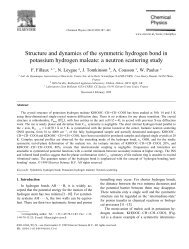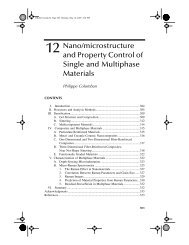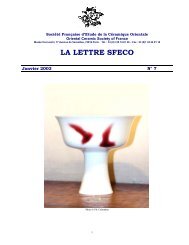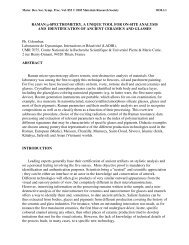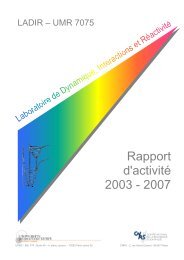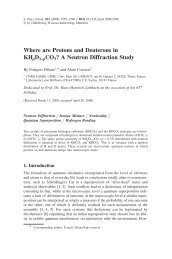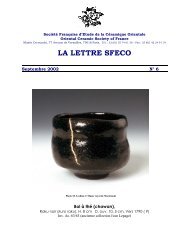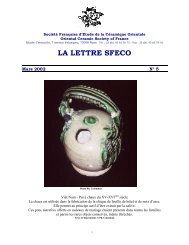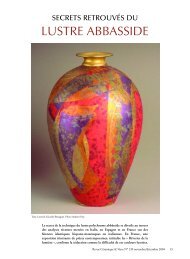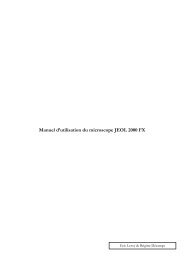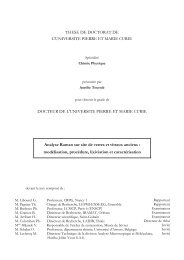Raman Spectroscopy of nanomaterials - institut de chimie et des ...
Raman Spectroscopy of nanomaterials - institut de chimie et des ...
Raman Spectroscopy of nanomaterials - institut de chimie et des ...
Create successful ePaper yourself
Turn your PDF publications into a flip-book with our unique Google optimized e-Paper software.
G. Goua<strong>de</strong>c, Ph. Colomban / Progress in Crystal Growth and Characterization <strong>of</strong> Materials 41xx (2007) 1e56As for r m , it corresponds to the effective matrix thickness responsible for the fibre stress. Avalue b w 0.03 mm 1 gave the best fit and the variation in Fig. 23c shows the axial compressionto rise from zero (at the tip) to its maximum value over a typical IL w100 mm.5.4. ‘‘MicroeMacro’’ correlationsARTICLE IN PRESS+ MODELIn this section, we will <strong>de</strong>monstrate how the local information accessed by RS through verysimple spectra fittings correlates with ‘‘macroscopic’’ param<strong>et</strong>ers such as Young’s modulus,tensile strength and micro-hardness. The reason why such a correlation exists is the common<strong>de</strong>pen<strong>de</strong>nce <strong>of</strong> the <strong>Raman</strong> signal and the mechanical behaviour on the micro/nanostructure<strong>of</strong> materials.5.4.1. Comparison <strong>of</strong> <strong>Raman</strong> Spectra with micro-in<strong>de</strong>ntation resultsStrong correlations b<strong>et</strong>ween <strong>Raman</strong> and microhardness data have been reported by Gogotsi<strong>et</strong> al. [133,486] for semiconductors, quartz and carbon and by Amer <strong>et</strong> al. [487] for ‘‘diamondlikecarbon’’. Fig. 24 illustrates how ‘‘mechanical changes’’ (Fig. 24c) are similarly related toa change <strong>of</strong> the <strong>Raman</strong> spectrum <strong>of</strong> either carbon or SiC nanoprecipitates (Fig. 24a and b) in anSCS-6 fibre. 36 The variations in Berkovich’s micro-hardness (mH; three-si<strong>de</strong>d diamond tip) andYoung’s modulus were measured by Mann <strong>et</strong> al. [489] and we highlighted different zones withvertical dots. From core to periphery, they correspond to:(I) The 32-mm diam<strong>et</strong>er carbon core consisting <strong>of</strong> graphitic units 1e5 nm in size [475].(II) A 1.5-mm thick layer <strong>of</strong> pyrolytic carbon (grains are 25e50 nm in size). It has been i<strong>de</strong>ntifiedas the weakest part <strong>of</strong> the fibre because its graphitic planes are parallel to the fibreaxis [489].(III) A zone in which carbon coexists with SiC and evolves over 30 mm towards a highly disor<strong>de</strong>redcarbon.(IV) A zone where only SiC is <strong>de</strong>tected (CeC bonds abundance 0.1%). The TO and LOband wi<strong>de</strong>ning and the increase <strong>of</strong> the background level reveal stacking faults are allthe more frequent as thickness increases [475]. In spite <strong>of</strong> this, the mechanical propertiesare constant, which suggests they are governed by free carbon in insertion.(V) The interfacial carbon <strong>de</strong>posit (thickness 3 mm).5.4.2. Comparison <strong>of</strong> <strong>Raman</strong> Spectra with fibre strengthFig. 25 shows the correlation <strong>of</strong> the strength measured on NLM [370] and Hi-Nicalon [383]SiC fibres annealed at different temperatures (up to about 1500 C) with their <strong>Raman</strong> spectrarecor<strong>de</strong>d at room-temperature. The linearity suggests that the macroscopic (strength measurement)and microscopic (<strong>Raman</strong> spectrum) responses to stress have the same <strong>de</strong>pen<strong>de</strong>nce ongrain size. A strength reduction resulting from grain boundary creeping is ruled out since itwould not alter the <strong>Raman</strong> spectra. Two atmospheres were tested for the NLM gra<strong>de</strong>. The mechanicalfailure is postponed in a reducing atmosphere but this does not seem to modify the‘‘microemacro’’ mechanical correlation.36 This is a 140-mm diam<strong>et</strong>er fibre used for m<strong>et</strong>al-matrix reinforcement [365]. It has a high h<strong>et</strong>erogeneity along theradius, due to a preparation by CVD <strong>of</strong> SiC (and carbon), on a carbon core [488].Please cite this article in press as: G. Goua<strong>de</strong>c, Ph. Colomban, Prog. Cryst. Growth Charact. Mater. (2007),doi:10.1016/j.pcrysgrow.2007.01.001



